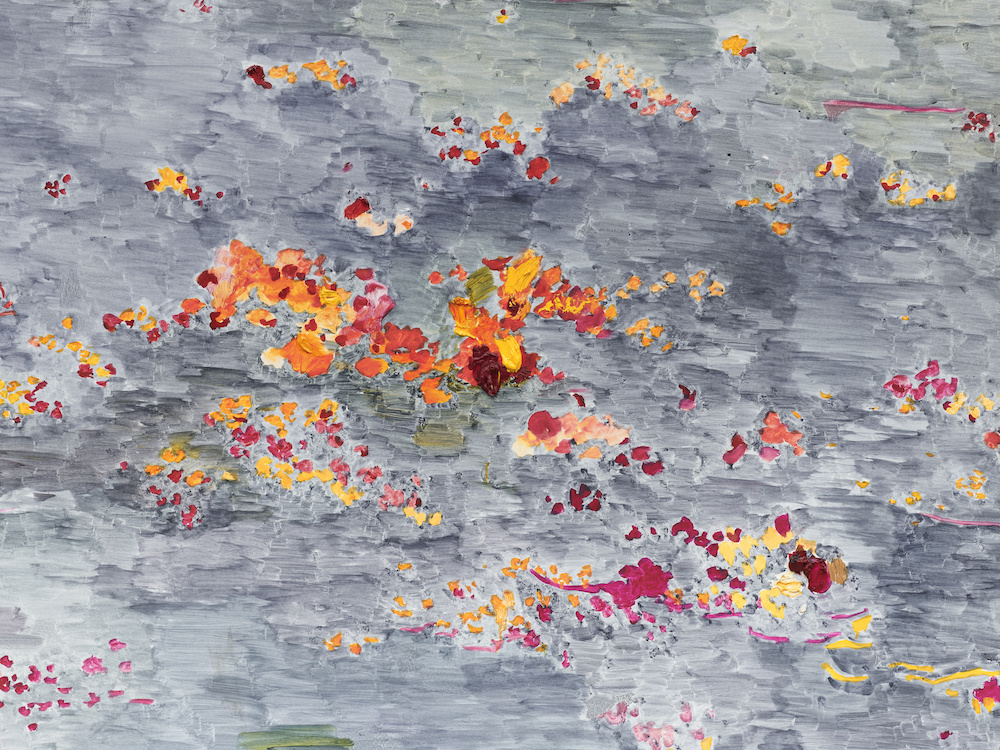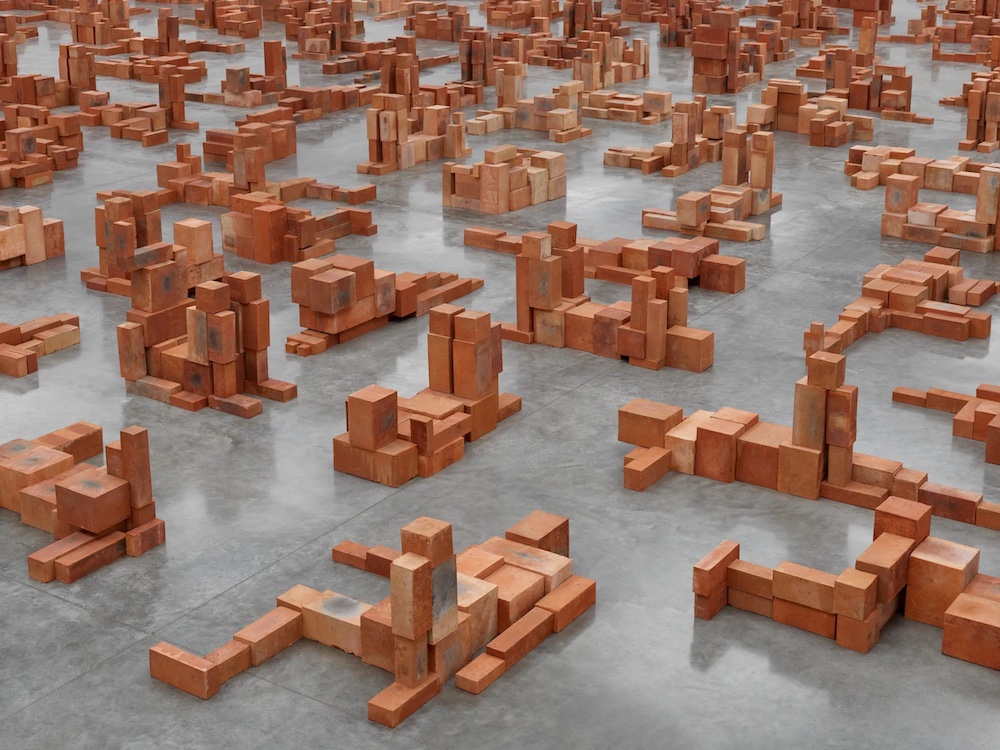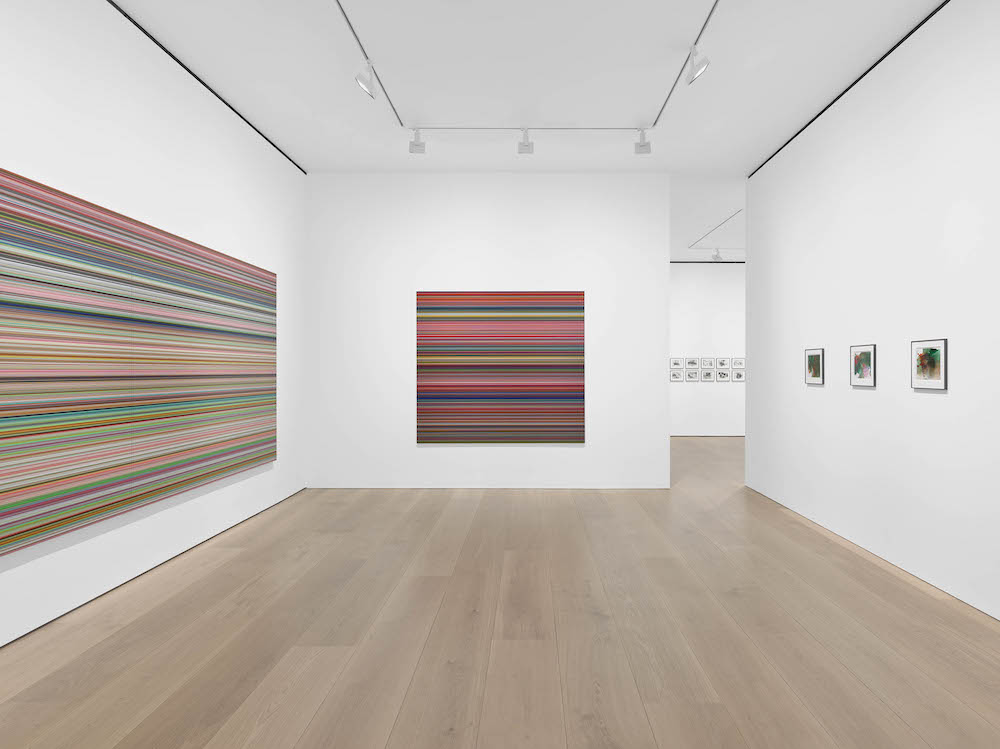White Cube Celebrates 30 Years and 20 Years at Frieze London
The art world and London have been profoundly shaped by the presence of White Cube. This iconic gallery has played a pivotal role in the development of the Young British Artist movement. It has defined the 20th- and 21st-century art scene by providing a platform for some of the most celebrated and influential contemporary artists of our time, including luminaries such as Michael Armitage, Tracey Emin, Antony Gormley, and Beatriz Milhazes to name just a few. With a global presence and multiple locations worldwide, White Cube continues to evolve and expand its reach. This renowned space acts as center stage for the art community at many international art fairs. Notably, this year White Cube celebrates its 30th anniversary, and its presence at Frieze London for the past two decades. Ahead of London Art Week, Leila Alexander, the Director of White Cube, spoke with Whitewall about the gallery’s rich history, its enduring significance, and its vision for the future.
How White Cube Started
WHITEWALL: Can you please provide a brief history and founding principles of White Cube?
LEILA ALEXANDER: White Cube was established in 1993 in a 4-metre squared space in St. James, London. It was then one of, if not the, smallest contemporary gallery in Europe, and over the last 30 years, we have developed to have multiple spaces across London, Hong Kong, Paris, Seoul, and New York. In 2011 we opened our flagship Bermondsey gallery in London. At the time of its launch, at approximately 58,000 square feet, was the largest commercial space operating in Europe and has welcomed well over 1 million visitors since opening. We are all thrilled to have just opened two new spaces: White Cube Seoul, in the Gangnam district, and White Cube New York which is in a purpose-built, 1930s former bank on the Upper East Side, at 1002 Madison Avenue.
White Cube is one of the few galleries in the world that were instrumental in the rise of an artistic movement. Our goal with primary artists is to secure their place in art history. With the estates we work with – including Al Held, Isamu Noguchi, Takis, and others – we conversely aim to find ways to make the historic contemporary, through scholarship, making new connections, and staging ambitious, ground-breaking presentations across our galleries.

Leila Alexander, the Director of White Cube, © White Cube.
WW: How has White Cube evolved since its inception, both in terms of its mission and the artists it represents?
LA: Of course, White Cube played a pivotal role in the rise of the YBA movement, but we have had an international outlook from the word go; our earliest space presented the first UK solo exhibitions of Hiroshi Sugimoto (1993), Doris Salcedo (1995), Luc Tuymans (1999); and Julie Mehretu (2002) alongside established figures such as Richard Prince (1997), and Ellsworth Kelly (2001).
Over the course of our history to date, our vision has only become more global. We were one of the first international galleries to open a location in Hong Kong. In the same year, we were the first international gallery to open a location in Brazil where we presented a three-year program of exhibitions in São Paulo.
As well as the opening of further brick-and-mortar spaces around the world, we have gradually increased the breadth and depth of artists and estates in our stable to over 60.
Key Milestones in the History of White Cube
WW: Could you share some key milestones or memorable exhibitions from the gallery’s past that have played a significant role in shaping its identity?
LA: White Cube has gained a reputation for its artist-led approach, facilitating the creation of ground-breaking works of contemporary art. A notable example of this is Christian Marclay‘s “The Clock.” We supported the production of this work over three years and it premiered at White Cube Mason’s Yard in 2010. It later received the Golden Lion at the 2011 Venice Biennale. It continues to be exhibited worldwide to critical acclaim and has earned its place in the art historical canon, widely acknowledged as a contemporary masterpiece.
Another moment that truly reflected who we are took place during the course of the Covid-19 pandemic. The brainchild of a special friend of the gallery, the late philanthropist, Nick ‘Hoppy’ Hopkinson MBE, we worked closely with Harland Miller to produce “Who Cares Wins,” an editioned “Penguin dust jacket” silkscreen print that raised some £2.5m for those working on the frontline against Covid-19 across the world. 100% of proceeds from sales were donated to the National Emergencies Trust in the United Kingdom, the New York Community Trust in the United States, and Hands On Hong Kong. Funds were also raised for the York Teaching Hospital Charity to support NHS staff in hospitals across Yorkshire, reflecting the artist’s close relationship with his hometown of York. It is very meaningful too that one of Harland’s Artist’s Proofs entered into the permanent collection of the Tate in recognition of the 2020 Covid-19 crisis and as representative of the response from the art ecology in the UK.
WW: In recent years, the art world has seen changes in how art is exhibited, executed and consumed through the rise of NFT art and of digital platforms. How has White Cube adapted to these changes in the present?
LA: The way the world engages with artists and artworks—due almost entirely to the evolving tech capabilities and reliance—has changed drastically in recent years. As a gallery, it is our responsibility to embrace these changes and leverage them in a way that is most beneficial for the artists that we work with. We’re doing interesting things with online programming, for example, “Salon” is a monthly online program showcasing outstanding examples of post-war and contemporary art from artists both inside and outside the gallery’s roster. To date, Salon has showcased exceptional secondary market works by artists including Alexander Calder, Carmen Herrera, Bruce Nauman, Wayne Thiebaud, and Andy Warhol.
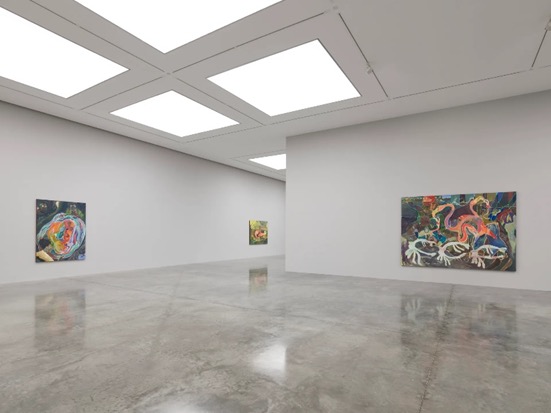
Michael Armitage, “Amongst the Living, with Seyni Awa Camara,” September 21–October 30, 2022 © White Cube.
What is the White Cube Concept?
WW: Can you please discuss any ongoing or upcoming exhibitions or projects that reflect the gallery’s current direction and artistic vision?
LA: Currently, at White Cube Bermondsey, we are honored to present Julie Mehretu’s most ambitious gallery exhibition to date. One of the most influential artists of her generation, Mehretu’s complex, multi-layered, calligraphic language is acutely attuned to the constant transformation of the political moment. Marking Mehretu’s fifth solo exhibition with White Cube, “They departed for their own country another way (a 9x9x9 hauntology)” debuts three new bodies of work across the entirety of our expansive galleries. Focused on enduring conflict, widespread displacement, and the asymmetry of power, Mehretu sources images from current affairs media, particularly the ongoing war in Ukraine and the events of the US Capitol insurrection on January 6, 2021.
The exhibition reflects our ongoing commitment to supporting and presenting world-class art, enabling our artists to fully realize their ambitions, and using the highest level of expertise to showcase and promote their work to the broadest international audience. It is a breathtaking example of art’s ability to transcend cultural, political, and geographical boundaries, to reflect societal change, to challenge perceptions, and to stimulate understanding.
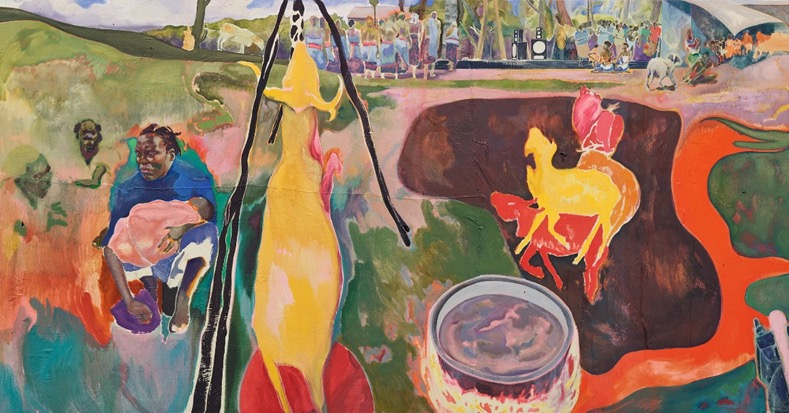
Michael Armitage, “Amongst the Living,” 2022, © White Cube.
20 Years of White Cube at Frieze London
WW: With White Cube’s longstanding presence at Frieze in London since its inception, how do you perceive the mutual influence and impact between the gallery and the fair over these 20 years?
LA: Against the backdrop of the establishment in 2000 of the global powerhouse that is Tate Modern, over the past two decades, White Cube and Frieze London have been complementary key driving forces in the development of the city’s role in the contemporary art market. We are proud to have been a part of Frieze London since the inaugural edition of the fair and have always considered it the most important week in the city’s cultural calendar. Strategically coinciding with auction week, Frieze London, together with Frieze Sculpture and Frieze Masters, attracts some of the world’s significant international collectors, curators, and museum directors. Bolstering Frieze’s international draw, we plan for months in advance to stage exhibitions of the highest caliber across our London real estate at White Cube Mason’s Yard and White Cube Bermondsey for this critical week, as well as of course at the fair itself.
WW: Can you please explain White Cube’s strategies for actively participating in and supporting both local and global art communities, particularly in its efforts to foster emerging artists and promote inclusivity within White Cube’s art spaces?
LA: As well as always looking for opportunities to shine a spotlight on previously overlooked or marginalized artists, a focus for us, and indeed one of the most exciting parts of our work is to identify and nurture the most exciting emerging talent from around the world and introduce them to new audiences.
One such example is Michael Armitage whose talent we spotted early at his Royal Academy of Arts degree show in London. A Kenya-born British painter, Armitage’s work weaves together East African history, folklore, and current events with Western painting traditions. His subject matter, coupled with his vibrant palette and use of Lubugo bark cloth—a traditional cloth by the Baganda people of southern Uganda which Armitage uses as a canvas—result in narratively rich and visually complex works. In 2015 we opened Michael Armitage’s first major solo exhibition in the UK at White Cube Bermondsey and in the past four years alone, he has gone on to enjoy solo exhibitions at numerous institutions including the Kunsthaus Bregenz, Austria; Kunsthalle Basel Royal Academy, London; Haus der Kunst, Munich; and MoMA, New York to mention just a few.
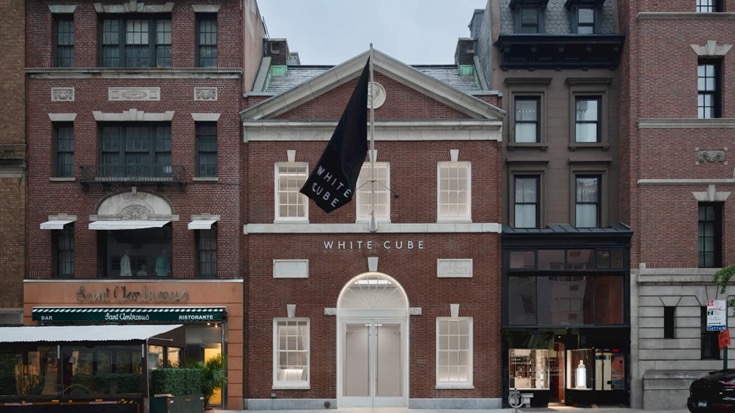
White Cube New York, 2023 © White Cube.
WW: Which emerging artists and art trends do you find particularly interesting at the moment?
LA: One of the most exciting young forces in the contemporary world for me personally is Marguerite Humeau. I am thrilled to have played a part in bringing her into our stable early last year. Humeau was born in 1986 in the French city of Cholet, near Nantes, and lives in London. She once brought together a “choir” of extinct animals by studying ancient mammoths’ skulls to construct models of their vocal tracts, through which she pumped compressed air. She has also used AI to summon the voice of Cleopatra from the depths of time. She creates extraordinary sculptural environments in which the scientific and the speculative are fused. Acknowledging the perilous present state of the planet and the future of humanity while exploring histories of life on earth across millennia, Humeau draws on mainstream and fringe scientific theory, science fiction, and various cultural phenomena, to create dramatic tableaux that are hugely distinctive in their visual language and subject matter. She asks fundamental questions about the world we inhabit and the meaning of human existence.
Already represented in the collections of the Tate London, MoMA, New York, and the Centre Pompidou, Paris, Humeau’s latest project is “Orisons,” one of the largest earthworks created by an individual woman artist to date. Spanning some 160 acres, she pays homage to the fragile ecosystem of Colorado’s San Luis Valley—the world’s largest alpine valley. If you find yourself in Colorado before June 2025, do not miss it!
WW: Can you please share any personal insights about your journey as the Senior Director of White Cube?
LA: I joined White Cube in 2005 as an assistant, having had my student years profoundly influenced by the rise of the YBA’s, the public furor and media frenzy caused by the Royal Academy of Art’s 1998 “Sensation” exhibition, and the impact of Charles Saatchi’s groundbreaking Boundary Road gallery in North London. Joining White Cube was a natural step, and it has been a whirlwind of magical experiences (not to mention extremely hard work and long hours!) working with an incredible, talented, and dedicated family of colleagues ever since. I am privileged to look after several of our senior artists and some of my most special moments have been conversations in their studios seeing artworks ahead of them going out into the world. From the buzzing private views at White Cube Hoxton Square in the early 2000s to the unveiling of Doris Salcedo’s iconic Shibboleth, a subterranean chasm that stretched the length of Tate Modern’s Turbine Hall, to holding Damien Hirst’s For the Love of God skull encrusted with 8,601 flawless diamonds, visits to Anselm Kiefer’s truly epic 200-acre studio-estate, La Ribaute in the south of France, to co-curating an exhibition in the historic setting of Arley Hall & Gardens in the English countryside, there is never a dull moment at White Cube!
Ultimately our artists are at the heart of everything we do and helping them to realise their ambitions is paramount. With this in mind, last October was a particularly memorable time witnessing the unveiling of the 6m high “ALERT,” Antony Gormley’s largest, permanent sculpture commission in London to date. After some three years of working on this project, at several points, it seemed as though it may not happen. Created for Imperial College London, and very generously gifted to Imperial by Brahmal Vasudevan and Shanthi Kandiah, we eventually got there, and this awe-inspiring sculpture is an exceptional example of Gormley’s oeuvre that will be enjoyed by generations to come.
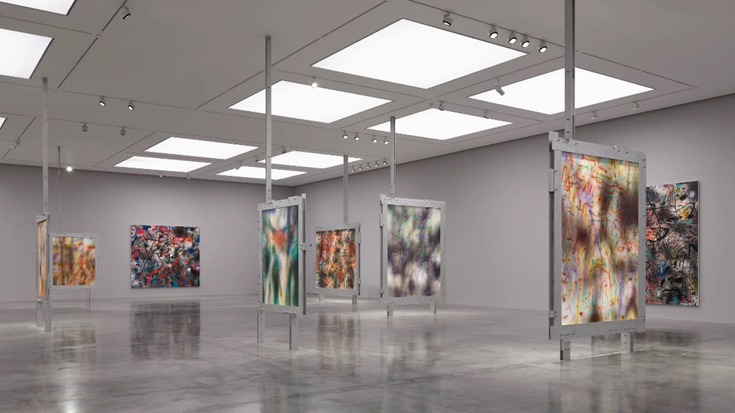
Julie Mehretu, “They departed for their own country another way (a 9x9x9 hauntology),” White Cube Bermondsey, September 15–November 5, 2023 © White Cube.
As Jay Jopling Says, Onwards!
WW: What lies ahead in the future for White Cube?
LA: 2023 marks 30 years of White Cube and in the past weeks we have celebrated the opening of two brand new galleries in both Seoul and New York. In the future, we will continue to grow our global network, and expand our team of global representatives. Alongside this, we plan to further grow our representation of artist estates and secondary market activity.
Right now, I cannot wait to experience the highly anticipated solo exhibition of new paintings by the formidable Tracey Emin at White Cube New York. Opening in November, this is the artist’s first show in the city in 7 years. In the words of White Cube’s founder, Jay Jopling, “onwards”!



